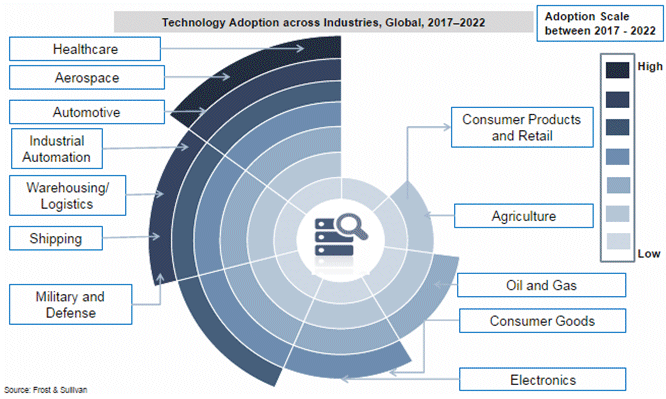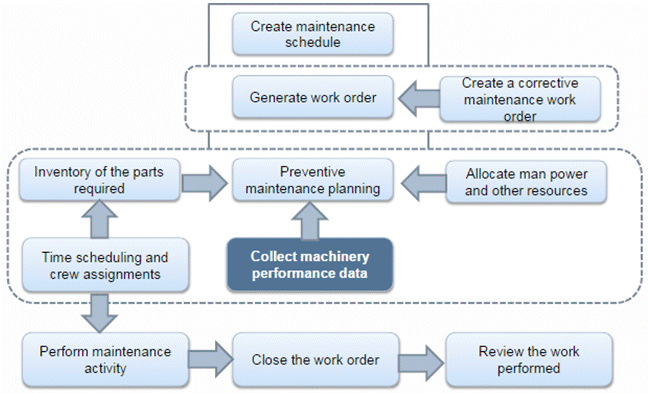With the advent of Industry 4.0 and smart factories, it has become a necessity for industries to adopt advanced technologies to improve their manufacturing processes. Asset-tracking and monitoring technology is currently adopted by industries for tracking and monitoring asset location and statuses. Sophisticated monitoring technology can also be categorized under plant asset management systems in which industries leverage such advanced technologies to prevent asset failure and to significantly improve asset performance.
This transformational technology is playing a vital role in many key industries or applications such as logistics, warehousing, healthcare, automotive, fleet management, military, and industrial automation. “The value and functionality of asset-tracking technologies has increased substantially owing to its ability to leverage the Industrial Internet of Things (IIoT) which is set to disrupt traditional manufacturing technologies,” says Mr. Andreas Kunze, CEO of KONUX, a Munich-based solutions provider of sensor analytics and predictive maintenance for industrial companies.
With industries striving to achieve Industry 4.0 and smart manufacturing, product-life cycle management, efficient process control, supply chain, value chain, and optimized logistics have increasingly become a necessity. Owing to this paradigm shift, asset-tracking solutions are being widely adopted and are anticipated to profoundly impact the growth of various industries in the coming years. This disruptive technology allows manufacturers to track an asset’s real-time location and status, and generate various reports which help them to monitor and take key actions accordingly. Owing to many advantages that this technology offers, it can be expected to have a high adoption rate in the next five years (2017–2022).
The Technology Adoption Scenario
The key market drivers for asset-tracking technologies are similar in varied industries such as automotive, aerospace, healthcare, locomotives, industrial automation, and logistics, wherein, with the requirement to improve product-lifecycle management and optimize the supply chain and value chain, industries are increasingly tracking and monitoring critical assets. A major driver for asset-tracking technologies is that they help industries to efficiently plan and optimize production using asset-tracking solutions to track subcomponents, child parts, and the finished parts.
This novel solution also helps in monitoring real-time data regarding machinery and equipment to plan maintenance activities. Industries involved in logistics, who are the main adopters of asset tracking solutions, are able to track vehicle location, movement, cargo status, and condition. These key drivers pave the way for the adoption of asset tracking technologies.
Currently, asset-tracking technologies are still in the “developmental” stage and undergoing enhancements. Even though there are numerous tracking and monitoring software platforms, there has been constant implementation of new technologies and methods to improve the performance, features, and precision of smart tracking devices. Some industries use this technology for tracking, monitoring, and physically securing valuable assets. As these smart tracking tags/devices are not fully tamper-proof, there is a relatively high chance and threat of confidential data being hacked and the asset being stolen. These challenges can be eliminated with further advancements of this novel technology.

Global Footprint Adoption
At present, the North American region is the leader in the development and adoption of asset tracking solutions. Industries such as consumer goods (clothing and furniture), aerospace, and defence are the top adaptors of asset-tracking technologies. Key participants in this industry are currently working on developing advanced software for asset-tracking and management. Technology development and wide-scale adoption intensity are high in this region.
From the European perspective, the adoption rate of asset-tracking technologies has been significantly high largely because of the domination of automotive, transportation, and aerospace industries. “Today, most companies in say, the railway sector, have extremely manual operations and, in Europe alone, rail companies are believed to be spending nearly US$ 5.4 billion in maintenance and inspection each year,” says Mr. Kunze. However, Europe has been contributing to the development of new technologies to monitor and track materials, components, and other assets (tools, molds, and so on) at the sublevel to reduce human intervention and automatically archive high production efficiency. “Our solutions are designed to entirely replace the manual operational system with our autonomous solution, which not only captures track-related data (like track-trigonometry changes over time), but also captures every minute train-related details in real-time, including speed, number of axles and anomalies, thus, saving companies billions in maintenance and supervision,” he states.
Another key observation that Mr. Kunze made was on how asset-tracking stimulates both predictive and preventive maintenance of assets, which inherently contributes toward reducing equipment downtime and increasing production efficiency.

The APAC region, on the other hand, is considered to be a heterogeneous market conductive to both technology development and wide-scale adoption. This region contains the largest manufacturers of electronics and consumer goods (consumer electronics and appliances), and asset tracking solutions are predominately being adopted by such industries to improve production/assembly efficiency and product quality. Wide-scale adoption of asset-tracking solutions is at medium intensity in this region, whereas the technology development intensity is relatively low.
Discerning Customer Needs
From the current standpoint, it is becoming clearer that, it is imperative for companies to appropriately discern customer requirements and market gaps before designing solutions in this space. Of the key market gaps, tools that enable real-time decision-making will most likely experience the largest demand as customers are expected to place more focus on maximising operating profits more than anything else. Moreover, solution providers in recent times are directing their efforts toward providing more enriched value additions for customers wherein, scope of solutions offered goes beyond just product development to providing continuous operational and business excellence to the customer. With large participants looking to expand into product-associated services and analytics, new business models aimed at long-term customer relationships are expected to flourish.
At the current rate of growth, the future of the analytics and asset-tracking market is expected to welcome project partnerships engaged in the continuous cycle of planning, execution and continuous value improvement, providing mutual benefit for the customer and the supplier.
Technology Roadmap and Convergence
The roadmap below depicts the development and impact of asset-tracking technology, which are anticipated to have on various manufacturing industries based on the current research, innovation, and technology development trends.
- By 2020: RFID tags with greater intelligence and memory at less cost to create intelligent assets are expected to be the next big thing by the end of this decade. Opportunities for passive RFID readers and tags providing more precise locations information are expected to find massive adoption rate in the near future. Advancements such as ultrasonic tags and transmitters (including smart ultrasonic tags) that do not require line-of-sight and can be more robust than RFID in complex indoor environments with multiple radio waves are expected to dominate the market.
- By 2021: Opportunities for precisely tracking an asset’s location using ultra-narrow band (UNB) technology will find maximum demand. Customers will also demand solutions such as wireless mesh networks that allow improved supply chain visibility or to more easily locate and communicate with smart devices.
- By 2022: The industry will be moving toward an era where opportunities for 3D printing RFID tags embedded in objects or products for easier asset-tracking will find growing demand and adoption.
The Last Word
With several new startups on the horizon specialising in advanced pattern recognition techniques, large participants will engage in merger and collaborative efforts with start-up companies for developing internal organisational solutions and for delivering distinct end-user results.
The next wave of innovation will affect analytics visualisation tools, which uses the language of the subject matter expert and shall require minimum operator training. Customised, plug-and-play solutions devoid of data scientists shall appeal more to first-time industry users.
With cybersecurity challenges increasing daily, analytics will have to foray into guarding machinery and process insights. There will be an exceedingly high demand among data-sensitive industries in the future for analytics with multiple parallel modules handling security and analytics in real-time.
About Frost & Sullivan
Frost & Sullivan’s expert analysts, research experts, and consultants continually evaluate and monitor the Oil & Gas market to develop timely and strategic market intelligence reports which includes growth drivers & restraints, market sizing, market shares, growth rates, competitive analysis, benchmarking, as well as regulatory & technology issues. Through our Oil & Gas Growth Partnership Services program, clients receive a continuous flow of actionable market, technical, and econometric intelligence, and effective strategies for growth. Our global team of market analysts, consultants, and industry experts continuously monitors the market and provides local expertise along with a global perspective.
F&S has experience in the following areas:
- F&S covers the entire value chain of O&G industry
- Value proposition for the industry
- Coverage of O&G services industry
Frost & Sullivan leverages almost 50 years of experience in partnering with Global 1000 companies, emerging businesses and the investment community from 31 offices on six continents.



